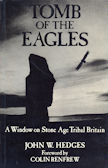In Tomb of the Eagles John W. Hedges describes vividly the activities of a tribal sub-group which had as its totem the magnificent white-tailed sea eagle. For these people the building and use of the tomb was symbol and expression of their identity. It was here that the dead joined their ancestors—but only after the flesh had been stripped from their bones. It was here, too, that offerings of food and goods were made according to the prescriptions and taboos of both group and society. Here that broken pots were piled; fish, eagles and joints of meat mouldered; and the hands of the living sorted the heaped bones of the dead.
There are many facets to this comprehensive overview of neolithic life; just one, for example, is the way the 16,000 human bones recovered are made to throw light on the stature, illnesses and even life-expectancy of the living. This is perhaps the essence of Tomb of the Eagles: not dry bones, but a glimpse of prehistory.
